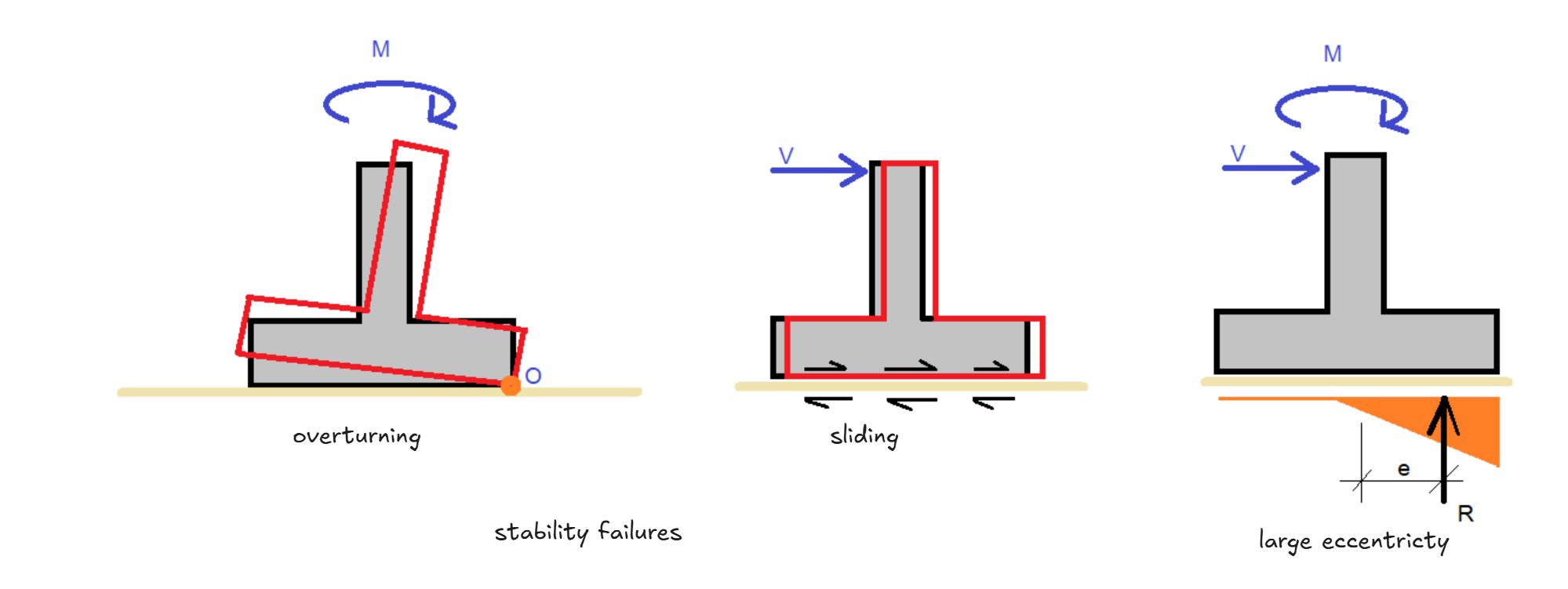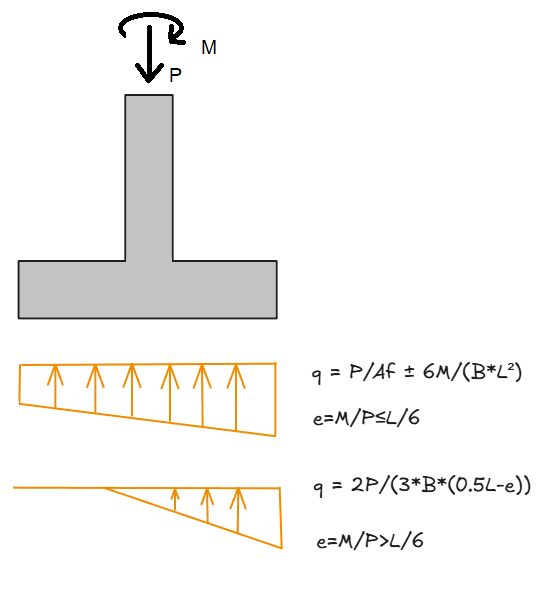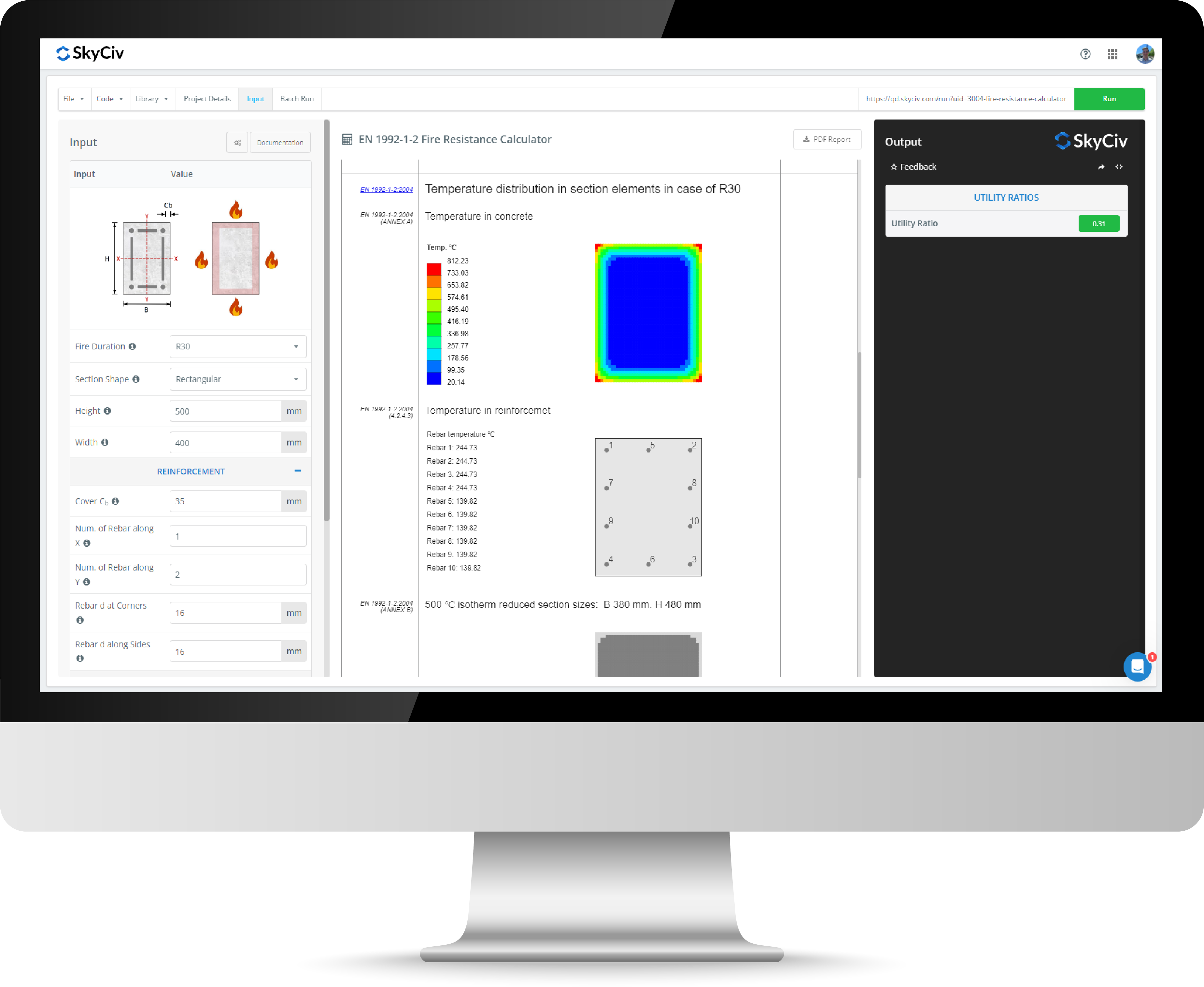Calculateur de conception de semelles filantes en béton armé
Les semelles filantes sont essentielles pour supporter les charges du bâtiment et les répartir en toute sécurité au sol. En tant que type fondamental de fondation superficielle, ils sont largement utilisés en raison de leur efficacité et de leur simplicité de construction. En ingénierie structurelle, la sélection et la conception correcte des semelles sont cruciales pour garantir à la fois la sécurité et la viabilité économique des structures.
Le calculateur de semelles filantes SkyCiv doit être utilisé pour l'analyse et la conception de semelles filantes basées sur l'ACI. 318-19 Norme de conception. Les contrôles utilisés dans le calculateur suivent les exigences du chapitre 13 du Code ACI relatif aux semelles filantes. L'outil de conception de semelles filantes peut traiter soit des semelles en béton armé, soit des semelles en béton massif conformément aux exigences du chapitre 14 de l'ACI 318 Standard. Ce module fait partie du Bibliothèque de conception rapide de Skyciv.
Table des matières
À propos du calculateur de conception de semelles en bandes SkyCiv
Définition de la semelle filante: Qu'est-ce qu'une semelle filante?
Une semelle filante est une fondation continue, fondation en béton allongée qui supporte des charges structurelles linéaires, généralement sous des murs porteurs. Il transfère la charge du mur vers une couche de sol située relativement près de la surface du sol.. Ce type de semelle répartit les charges concentrées de la superstructure sur une zone de sol plus large., réduire la pression et atténuer les risques de règlement. La couche de sol doit avoir une capacité portante adéquate et une profondeur suffisante pour éviter le soulèvement dû au gel et d'autres problèmes environnementaux..
Quand faut-il utiliser des semelles filantes?
Les semelles filantes conviennent mieux aux structures avec murs, comme les immeubles résidentiels, écoles, et installations commerciales légères. Ils sont idéaux lorsque le sol a une capacité portante adéquate à faible profondeur., et les charges imposées sont modérées et uniformément réparties. Les applications courantes incluent le support de murs en maçonnerie ou en béton, colonnes continues, et situations dans lesquelles les semelles isolées ne sont pas pratiques en raison de la géométrie du mur ou de la répartition des charges..
Types de semelles filantes
Habituellement, deux types de semelles filantes sont utilisés:
- Semelles en bandes de béton ordinaire - qui sont idéales pour les structures plus légères et les bâtiments de faible hauteur avec des sols porteurs stables.
- Semelles en bandes de béton armé - qui sont utilisés pour des charges plus lourdes ou lorsqu'une durabilité accrue est requise en raison des conditions environnementales. Ils conviennent aux structures plus lourdes où la capacité portante du sol est relativement faible..
Renforcement des semelles filantes
Le renforcement de flexion est généralement placé au bas de la semelle., perpendiculaire à la face du mur. Dans le sens transversal, le renforcement du retrait et de la température doit être prévu parallèlement à la longueur du mur.
Chargement des semelles filantes
Les semelles filantes supportent généralement des charges linéaires sous les murs porteurs.. Par contre, dans certains cas, une ligne de colonnes rapprochées peut également être soutenue par une semelle filante.
Modes de défaillance pour les semelles filantes
Les modes de rupture des semelles filantes peuvent généralement être classés en trois catégories.: ruptures de roulement du sol, échecs de stabilité, et défaillances structurelles. Ceux-ci sont illustrés dans la figure suivante.


Figure 1: Modes de défaillance des semelles filantes
Procédure de conception des semelles filantes (ACI 318-19)
La conception des semelles filantes implique plusieurs étapes en raison des différents paramètres et variables qui affectent les dimensions et caractéristiques finales..
Étape 1: Enquête géotechnique et considérations
Le dimensionnement des fondations nécessite généralement de déterminer le comportement et la déformabilité liée aux contraintes du sol sous la fondation.. Pour y parvenir, les propriétés géotechniques du sol doivent être déterminées. Ces propriétés incluent la distribution granulométrique, classification des sols, plasticité, compressibilité, et résistance au cisaillement. L'enquête vise à déterminer l'adéquation des différents types de fondations et la capacité portante du sol.. Ce processus comprend normalement l'exécution du calcul de la capacité portante ultime et d'une analyse de tassement.. Ces étapes déterminent la pression de roulement admissible (qa) pour éviter les ruptures de roulement du sol. Si une fondation en bande convient, l'ingénieur peut alors passer à l'étape suivante.
Étape 2: Contrôles de stabilité
Assurez-vous que le système de fondation est protégé contre le renversement, glissement, et éviter les soulèvements excessifs dus aux excentricités.
Étape 3: Définir la zone de base
Aux États-Unis, ceci est déterminé en utilisant la contrainte admissible et les combinaisons de charges de service. Les valeurs porteuses présumées (Tableau IBC 1806.2) peut également être utilisé si cela est autorisé. La contrainte admissible est normalement incluse dans le rapport géotechnique, compte tenu de la capacité portante et des tassements possibles. En semelle filante, la contrainte du sol pour une semelle avec une charge axiale (P) et moment (M) peut être calculé comme le montre la figure 2.

Figure 2: Calculs de contrainte du sol dans les semelles filantes
Étape 4: Définir l'épaisseur de base et calculer l'armature de flexion
Cela se fait normalement par une procédure d'essais et d'erreurs pour éviter toute défaillance structurelle.. Dans le cas présent, une épaisseur de semelle est adoptée, puis la résistance à la flexion et au cisaillement est vérifiée. Dans cette étape, la semelle doit être conçue pour les moments de flexion, cisaillement unidirectionnel (le cisaillement bidirectionnel ne s'applique pas aux semelles filantes) causée par la pression du sol due aux charges pondérées. Une profondeur minimale de 6 dans devrait être considéré (ACI 318-19 c13.3.1.2) et un enrobage minimum égal à 3 pour béton coulé et en contact permanent avec le sol (ACI 318-19 c20.5.1.3.2). Il est également important de considérer l'épaisseur minimale de la semelle en fonction du développement des barres qui partent de la semelle jusqu'au mur pour les murs en béton..
Si le diagramme des moments de flexion est analysé (voir la figure 2), il apparaît que le moment maximum dans la semelle filante se produit sous le milieu du mur, mais des tests ont montré que ce n'est pas correct à cause de la rigidité des murs. Le code ACI suggère (ACI 318-19, c13.2.7.1) le calculer en face du mur pour les murs en béton armé ou sur une section à mi-chemin de la face du mur jusqu'à son centre pour les murs en maçonnerie. Dans les calculs, il suffit de prendre en compte la pression ascendante provoquée par les charges externes appliquées à la semelle. Le poids propre et le poids du sol des morts-terrains doivent être négligés.. Seules les pressions nettes sur la semelle doivent être utilisées pour la conception structurelle..

Figure 3: Diagrammes de cisaillement et de moment pour une semelle de mur avec des pressions de sol uniformes
Si la semelle du mur est chargée jusqu'à ce qu'elle se brise en cisaillement, la rupture ne se produira pas sur un plan vertical au niveau de la face du mur mais plutôt à un angle d'environ 45° avec la face du mur, donc la section critique pour le cisaillement est calculée à une distance « d » de la face (ACI 318-19c13.2.7.2), étant « d » la profondeur effective, voir la figure 3. La profondeur effective est calculée comme:

où h est l'épaisseur de la semelle, c est la couverture, et db est le diamètre de la barre.
Une fois le moment de flexion maximum (Mu) à la section critique a été déterminé, la zone de renforcement requise (As) est déterminé de la même manière que n’importe quel élément de flexion. Bien qu'une semelle ne soit pas une poutre, il est souhaitable qu'il soit ductile en flexion, et cela peut être fait en limitant la déformation nette de traction dans l'armature de tension (et) à une valeur supérieure à εty + 0.003 (ACI 318-19 c21.2.2, ety est égal à fY/Es).
Avec la première hypothèse, la zone de renforcement requise peut être calculée avec les équations suivantes

b est la largeur de la section, F'c est la résistance à la compression spécifiée du béton, FY est la limite d'élasticité spécifiée du renfort, et Es est le module d'élasticité de l'armature en acier.
La résistance au cisaillement est normalement calculée uniquement en considérant la contribution du béton. Il n'est pas conseillé d'utiliser des armatures de cisaillement en raison de l'augmentation des coûts. Par conséquent, le cisaillement calculé au niveau de la section de cisaillement critique doit être supérieur à la résistance résistée par le béton. Il est calculé à l'aide de l'équation donnée dans le tableau 22.5.5.1(c) (ACI 318-19 c22.5.51)

Où ρw est le taux de renforcement égal à As/(b×d), λ est le facteur de modification pour refléter les propriétés mécaniques réduites du béton léger, et ϕ est le facteur de réduction de cisaillement.
Une fois que l'épaisseur de la semelle est confirmée pour résister à la flexion et au cisaillement unidirectionnel, et le renfort adopté est plus grand que celui requis, nous pouvons continuer avec l'étape suivante.
Étape 5: Calculer les forces de transfert
Les forces verticales et horizontales transférées à la semelle par l'appui du béton ou une combinaison d'armatures d'appui et d'interface doivent être vérifiées.. Cette exigence est détaillée dans la section 22.8 de l'ACI 318-19:

Où un1 est la zone chargée, A2 est l'aire de la base inférieure du plus grand tronc de pyramide, cône. Les côtés de la pyramide, cône, ou le coin conique doit être incliné 1 verticale à 2 horizontal. Et ϕ est un facteur de réduction.
Étape 5: Contrôles de détail
La dernière étape est consacrée aux détails du renforcement comme espacement minimum et maximum, longueur de développement jusqu'aux sections critiques. Les détails sont donnés au chapitre 25 de l'ACI 318-19.
Bande vs. Semelles murales
Les semelles murales sont essentiellement un sous-ensemble des semelles filantes et sont souvent utilisées de manière interchangeable., car les deux décrivent un continu, semelle étroite qui supporte des charges linéaires. Par contre, les semelles filantes ont une définition plus large et peuvent également supporter une ligne de poteaux rapprochés, accepter des charges ponctuelles disposées en rangée. En termes de renforcement, les deux types sont similaires.
Semelles en bandes vs semelles écartées ou coussinées
Les semelles filantes sont étroitement liées à semelles écartées, car les deux sont des types de fondations peu profondes couramment utilisées dans les structures petites et moyennes en raison de leur faible coût. Les semelles filantes sont généralement longues et rectangulaires, tandis que les semelles plates peuvent être carrées, rectangulaire, ou circulaire. Les semelles filantes supportent généralement des charges linéaires, tandis que semelles plates supporter des charges concentrées. En conception, tous les contrôles effectués pour les semelles filantes doivent également être appliqués aux semelles réparties ou à semelles plates., avec des contrôles supplémentaires tels que le cisaillement à double sens (perforation) Chèque.
Comment utiliser le calculateur de semelles de mur?
L'outil de semelle de mur fonctionne selon une philosophie d'essais et d'erreurs. L'utilisateur peut modifier les données d'entrée jusqu'à ce que tous les contrôles soient réussis. Normalement, quand il y a des échecs, la solution consiste à agrandir la semelle ou à augmenter le renfort. Dans tous les cas, l'outil vérifie également les conditions minimales et maximales qui permettent d'éviter un renforcement excessif. Il est suggéré d'augmenter la hauteur en cas de rupture par cisaillement, agrandir la largeur pour les échecs de stabilité, et incrémenter la zone de renforcement pour les ruptures de flexion lorsque la hauteur de la semelle et les contrôles de cisaillement sont corrects.
Points clés - Semelles filantes
- Les semelles filantes sont économiques et largement utilisées pour les fondations peu profondes.
- Une enquête géotechnique appropriée est essentielle.
- La conception doit tenir compte de la capacité du sol, règlement, résistance structurelle, et stabilité.
- Suivre l'ACI 318-19 pour tous les contrôles et détails.
Références
- ACI 318-19: Exigences du Code du Bâtiment pour le Béton Armé
- Tableau IBC 1806.2: Valeurs porteuses présumées
- CRSI, Guide de conception sur l'ACI 318 Exigences du Code du Bâtiment pour le Béton Armé, CRSI (2020).
- Béton armé: Mécanique et conception 6e édition par James K. Wight, James G.. MacGregor.
Questions fréquemment posées
Quel angle de frottement fondation-sol doit être utilisé?
Cet angle est normalement compris entre la moitié et les deux tiers de l'angle de frottement du sol.. ("Principes de l'ingénierie des fondations" de Braja M.. Le)
Quels facteurs de réduction sont utilisés dans les vérifications de résistance?
Le calculateur de semelles filantes ACI utilise φ = 0.75 pour cisaillement, φ = 0.90 pour plier (pour le béton armé dans l'hypothèse d'une condition de tension contrôlée impliquant une zone d'armature inférieure à la limite maximale pour cette condition), φ = 0.60 pour le cintrage du béton ordinaire, et φ = 0.65 pour roulement.
Quelle valeur est utilisée pour le poids unitaire du béton ?
La valeur par défaut utilisée est 150 lb/pi3 comme suggéré par la norme pour le béton de poids normal.
Quelle valeur du poids unitaire du sol peut être utilisée?
Les valeurs communes se situent entre 90 à 130 lb/pi3. Il est conseillé d'utiliser la valeur humide suggérée dans le rapport géotechnique du projet..
Le renforcement des murs est-il utilisé dans les calculs?
Il n'est pas utilisé, uniquement à des fins de dessin. Les chevilles murales, toutefois, sont utilisés dans le contrôle du transfert des forces de charge.
Pourquoi mon pied a-t-il un petit espacement maximum?
L'ACI 318-19 Section 24.3.2 spécifie des valeurs assez faibles compte tenu des valeurs utilisées pour l'enrobage en béton (normalement autour 3 pouces). Quelques références (Éviter les utilisations problématiques des dalles au sol, Jan, 2021 Magazine Structure Par Alexander Newman, P.E., F.) mentionner que l'ACI devrait envisager d'exempter ces dispositions pour les semelles et dalles au sol, mais , à partir de maintenant, ils s'appliquent toujours, et donc ils sont inclus dans le programme.
- SkyCiv Quick Design
- Calculateur de capacité de roulement
- ACI 360 Calculateur de conception de dalles sur sol
- Calculateur de semelles écartées
- Calculateur de Conception de Pieux Visés
- AS 2870 Calculateur de conception de dalles sur sol
- Calculatrice de stabilité de la pile latérale
- Calcul de conception de colonne en béton armér
À propos de SkyCiv
SkyCiv propose une large gamme de logiciels de conception et d'analyse structurelle en cloud pour les ingénieurs. En tant qu'entreprise technologique en constante évolution, nous nous engageons à innover et à remettre en question les méthodes de travail existantes pour faire gagner du temps aux ingénieurs dans leurs processus de travail et leurs conceptions.



